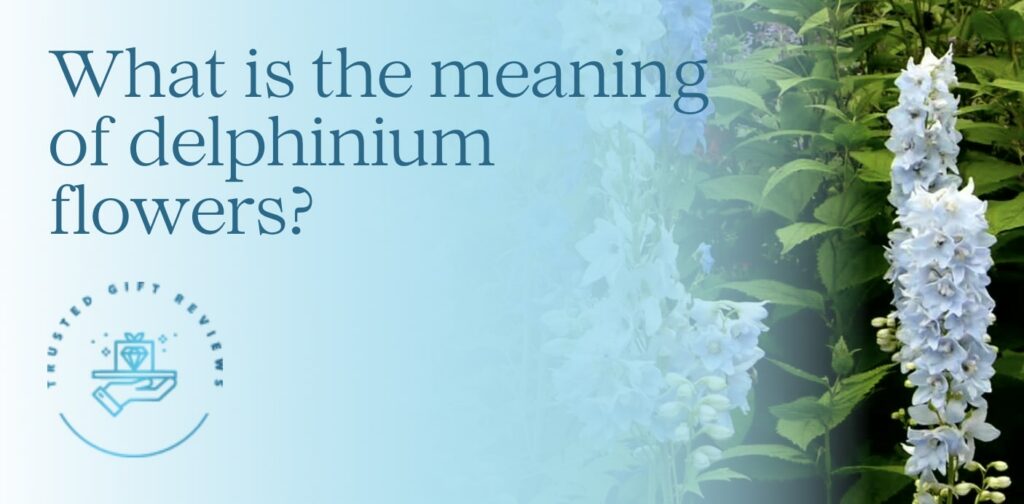Abounding in flowers and beauty, delphiniums (aka larkspurs) are regarded as a symbol of joy, cheerfulness, and camaraderie.
In the past, they were believed to ward off bad luck, negative energy, and evil spirits.
Find out more about the delphinium plant in this simple, informative guide. Here, we will be discussing its basic botanical features, its meaning and symbolism, how to take care of it, and more.
About Delphinium Flowers


Genus: Delphinium
Family: Ranunculaceae
Native Habitat: Northern Hemisphere and the high mountain regions of Africa
Life Cycle: Annual, biennial, or perennial
Delphinium is a genus of flowering herbs with over 300 species. All of these plant varieties belong to the family of Ranunculaceae.
There are dwarf, medium, and tall-sized delphiniums. The smallest one can reach between 10 and 12 inches, while the largest one can amazingly grow up to six feet tall.
The enchanting and lively flowers are native throughout the Northern Hemisphere and the high mountain regions of Africa. They thrive best in sunny and shaded areas.
Some start as seeds, but others don’t. They can be grown as annual, biennial, or perennial plants, making them one of the favorite flowers of many gardeners and homeowners.
Botanical Description of Delphiniums


In general, delphiniums are beloved for their showy mass of flowers, great height, and several varieties of colors, of which purple and blue are the most common.
Viewing it from afar, you can also observe that the flower’s spur resembles a dolphin’s tail or a magical sword of a knight.
Also, being an elaborate plant species, they can have different flower and sepal structures and numbers. They can be single, semi-double, or double form.
Let’s take a brief look at each of these delphinium flower types:
- Single-Form Delphinium
This flower type of delphinium has five sepals. The petals on top radiate from a central point, and the sepals, which are sometimes called “honey leaves,” have colored hairs.
- Semi-Double-Form Delphinium
Semi-double delphiniums are a richer kind than single-form ones. It comes with eight inner petals and five sepals.
- Double-Form Delphiniums
As the name suggests, they have twice as many petals and sepals. Do note, however, that these flowers don’t necessarily have “eyes” or small central flowers.
Whichever form they take, delphiniums are perfect for summer gardens with their superb and dramatic spurs. And they can contrast well with cut roses, lilies, and hydrangeas.
Delphinium Flower Word Origin


Delphinium is derived from the Greek word delphī́nion and its older version, delphī́s. It accurately means “dolphin,” in reference to the unique shape of the flowers.
Delphinium Flower Meaning and Symbolism


Delphinium is one of the most popular flowers out there. In fact, it’s one of the two official flowers of July, with the other one being water lily.
The vibrant flower spur has the special meaning of bliss, optimism, protection, and goodwill. It can also have a connotation of romantic attachment and an open heart.
Moreover, the specific color it has gives it a different meaning, which we’ll explore further below.
For instance, deep blue means dignity and bravery, purple means royalty, pink means affectionate love and care, and white stands for elegance and purity.
Delphinium Meanings by Color


- Purple
When thinking of delphiniums, purple ones may come to your mind. Purple gives these flowers a complementary meaning of pride, wisdom, luxury, and nobility.
Other great meanings of purple are peace, devotion, grandeur, independence, and magic.
And so, given these qualities, a purple delphinium bouquet can make a person feel very special, especially if they’re tying the knot or celebrating a work achievement.
- Blue
Blue is another amazing and common color of delphiniums. The color signifies trust and loyalty as well as peace, confidence, security, calmness, and security.
Seeing them in one’s garden can rejuvenate a stressed and anxious person besides beautifying the property. Also, it makes for an excellent pairing with other hues of flowers.
- Scarlet
Scarlet has an interesting meaning concerning religion. Even up to now, the color is worn by the cardinals of the Roman Catholic Church.
Hence, many people associate scarlet with devotion, sacrifice, and respect. In the general sense, scarlet means warmth, joy, passion, and courage.
Though it’s warmer and more striking in tone, scarlet is equally as beautiful as other colors like blue and purple.
- Pink
Soft and lovely, pink delphiniums convey happiness, love, and politeness. The sweetness of the flower comes out with this color.
Apart from that, the delicateness and lightness of pink give it the meaning of innocence, youth, and happiness. And it’s the color that represents women or womanhood too.
Mother’s Day and Valentine’s Day are just some of the perfect occasions to gift someone pink delphinium flowers.
- White
White is the purest of them all with meanings of purity, innocence, and inner peace. Other meanings are refinement, cleanliness, and a new beginning.
White delphinium is an ideal gift for important life events and milestones, like baby showers, weddings, graduations, and silver or golden anniversaries.
What’s more, if you have wronged someone and are asking them for forgiveness, or showing someone you love them unconditionally, white delphiniums could be a great choice!
How to Care for Delphiniums


While it’s relatively easy to grow delphiniums, they still involve work to maintain.
To help you out with this, we have listed several care aspects you should handle so your delphinium flower can grow vigorously and beautifully.
- Planting
Plant your delphiniums in slightly moist, fertile, and well-draining soil. They have to be situated in areas where they get full or filtered sunlight.
And remember to give 1 to 3 feet of spacing between the plants on the garden bed to allow airflow. Also, ensure that the top of the root ball is level with the soil line.
- Watering
Aim to regularly water your delphiniums every week. They get thirsty a lot just like all perennial plants.
But as you do so, don’t let the water touch or pool around the foliage to avoid root rot and fungal spots.
Also, you should water the plant more often during scorching summer days to prevent the soil from drying up.
- Fertilizing
Delphiniums need to be fed with plant food twice—first, when they start to grow in early spring, and second, when they flower in midsummer.
We recommend using a balanced 10-10-10 granular fertilizer to ensure the plant develops healthy roots, stems, and leaves as well as stunning and abundant flowers.
- Staking
Wind and rain are the archenemies of delphinium flowers. Since their stems are hollow and lanky, they can break easily or tip over when a certain amount of force is applied to them.
The solution to this is to stake the delphinium flowers, preferably, early in the growing season. This way, they can grow in your garden without any hindrance.
- Deadheading
To promote more lovely flowers to bloom, you might need to deadhead your delphinium flowers.
This process requires you to remove dead or withered flowers or sometimes, even cut back the plant at the base if no flower buds are growing.
- Pests and Diseases
In the course of its life, certain pests and diseases may affect your delphinium, especially, if there’s a shortcoming on your part in taking care of it.
Common spot diseases for this plant are powdery mildew, black leaf spot, and Botrytis blight, to name a few.
Most of these are caused by overwatering and poor air circulation. In order to avoid this, ensure adequate spacing when planting the flowers and water only at the base of the plant.
As for the aggressive delphinium pests, these include aphids, spider mites, and leaf miners.
Aphids make the leaves curled and deformed, spider mites stunt and damage the plant’s growth, and leaf miners bite from within the plant resulting in unsightly patches and dead cells.
To completely get rid of these deadly insects, spritz the delphinium plant with water or organic neem oil or use insecticidal soap.
FAQS about Delphinium Flowers


- How was the delphinium flower regarded back then?
Delphinium symbolizes protection both then and now. In ancient times, peasants used this flower to repel scorpions and their extremely painful sting.
The flower was also used for its blue dye by native Americans and Europeans for clothing, handicrafts, ceramics, furniture, and other things.
- Are delphiniums toxic?
They may be beautiful, but delphiniums are poisonous to humans and their pets.
As a result, one should be careful not to bring these plants inside the house within the reach of children and pets.
- Can I grow delphiniums in pots?
Although delphiniums are best grown in the ground or flower bed, they can also be grown in a suitable pot vessel.
The container you choose should be free-draining. Choose can be one with drainage holes, and put it on a stand a few inches above the ground to allow excess water to flow out.
- How long is the blooming time of delphiniums?
Delphiniums bloom for several weeks from early to midsummer, mostly in June and July.
Of course, correct care and adequate nutrients play a crucial role in the ensuing beauty, color, and longevity of the flowers. So, always make sure you’re fulfilling the plant’s sun, water, and soil needs for optimal results.
- Do delphiniums flower more than once?
It depends on how you’ve taken care of the delphinium. Usually, proper pruning will rejuvenate the flower and enable a second wave of flowering in August and September.
But keep in mind that for best results, you can prune the plant during midsummer, which is when the flowers have faded or fallen off.




